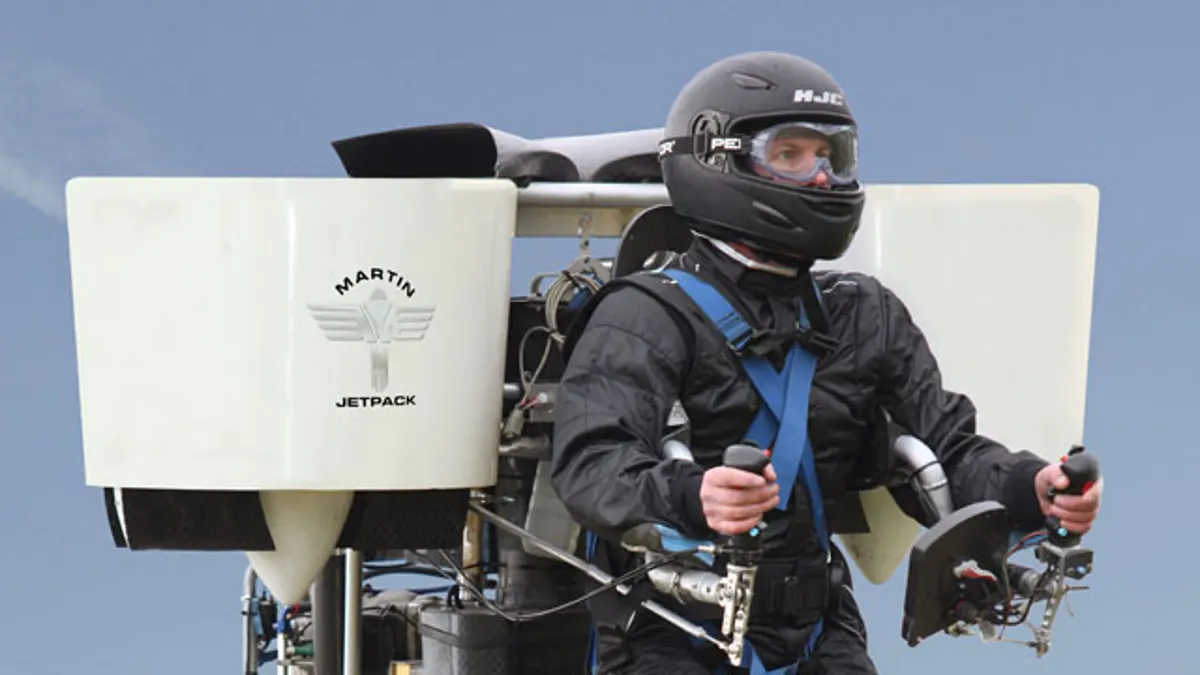
(Martin Aircraft Co.)
Flying cars and robot maids may still be far from reality, but one Jetsons-era vision of the future is very real: the jetpack.
After nearly 30 years in development, New Zealand's Martin Aircraft Company is finally gearing up to sell its jetpack: two rockets driven by a 2-liter, 200-horsepower engine that can theoretically take you as high as 8,000 feet.
The company is currently taking commercial orders, but Martin expects it will be selling the devices to individuals late this year.
With a range of 31 miles and a maximum speed of 63 miles per hour, you'll be able to jaunt to the store at will, or to the gas station for a fill-up. That's right, Martin's jetpack uses ordinary gasoline, not jet or rocket fuel.
The future is now, though it'll cost you around $100,000. So why buy a jetpack rather than, say, a midsize sailboat or a high-performance motorcycle?
Well, for one thing, boats require a license. The Martin jetpack, on the other hand, was designed to meet the Federal Aviation Administration's Part 103 regulations, which govern "ultralight" vehicles that don't require a pilot's license (though the company does require you to enroll in its training class prior to flying).
But the FAA isn't even certain that jetpacks will fall under its regulations. A spokeswoman from the FAA's communications office wavered on whether jetpacks would be covered by Part 103, telling us at one point "we do not regulate jetpacks."
Ultimately, she decided that jetpacks would be covered ... probably. "As long as they meet the definition of an ultralight, they are not required to have an aircraft certification, pilot license or register the aircraft," she said.
Assuming you fit Martin Aircraft's description of the ideal flyer -- meaning you weigh between 140 and 240 pounds -- will you be able to strap yourself in and fly to the corner store for a half-gallon of milk and some chips?
Maybe. The FAA dictates that you won't be able to fly at night -- jetpacks are allowed only from dawn to dusk. But that's OK: The Martin jetpack doesn't have any operating lights.
The FAA also wags its finger at flying in town, warning that "no person may operate an ultralight vehicle over any congested area of a city, town, or settlement, or over any open air assembly of persons." And a slew of complicated regulations dictate how high you can fly, based on the visibility of clouds.
So owning a jetpack won't all be fun and games if the FAA ultralight regulations apply. If not, anything goes.
There's one more perk to flying over driving: You won't have to insure your jetpack. In fact, you probably won't even be able to. Companies like Avemco, which offers direct-to-customer insurance for private aircraft owners, have no plans to step into jetpack insurance.
Mike Adams, an underwriter for the company, notes that only four or five states require liability insurance to register and operate a private plane. The majority of owners of private aircraft do insure their vehicles anyway, just as they would a car, he explains. But how people will do that for jetpacks, or how the FAA will respond, is an open question.
"It's neither fish nor fowl. Is this regulated by the FAA or is it a personal vehicle like a bicycle or ATV? I don't think anyone knows yet," Adams mused.
What about the neighbors? You're not supposed to fly an ultralight vehicle over "congested areas," but what about in your backyard? And what about in a small town or a more rural city? That could be out, according to FAA regulations, though how they would monitor backyard flight is unclear.
Bottom line ... if you're the one with the jetpack, good news! If it's your neighbor, convince him that his flight path shouldn't be over your house.
Martin Aircraft Company hopes to sell 500 jetpacks annually at a price of about $100,000 per unit, according to the International Business Times, and has partnered with an unnamed international aircraft company to make it happen. If you've got 100 grand burning a hole in your pocket, the future looks fun indeed.
